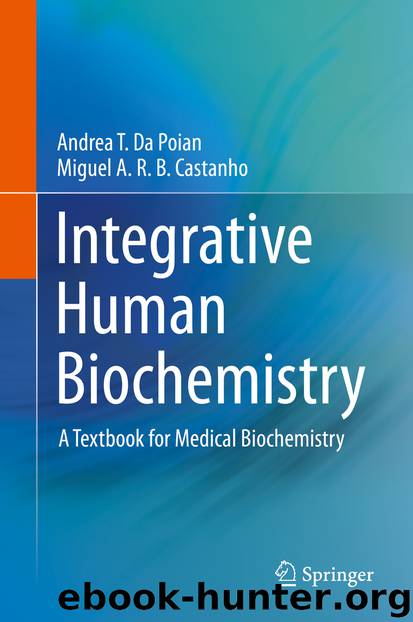Integrative Human Biochemistry by Andrea T. da Poian & Miguel A. R. B. Castanho

Author:Andrea T. da Poian & Miguel A. R. B. Castanho
Language: eng
Format: epub
Publisher: Springer New York, New York, NY
6.2.4.2 The Mechanism of ATP Synthesis by the ATP Synthase
The synthesis of ATP from ADP and Pi is a very endergonic reaction in aqueous solution. However, one important point to understand the mechanism of ATP synthesis by ATP synthase is that when occurring in F1 environment, it is readily reversible, with a free-energy change close to zero (see Box 6.2). For the reaction catalyzed by F1, the energy barrier consists in the step of ATP release from the enzyme . This energy barrier is overcome by the energy input from the H+ gradient, since flow through Fo promotes conformational changes in the β-subunit, leading to the loss of its affinity to ATP.
This view of ATP synthesis was formulated by Paul D. Boyer. From his kinetic studies, two main new concepts emerged. The first was that the three catalytic sites of the ATP synthase participate sequentially and cooperatively in the catalytic cycle; the second was that the catalytic mechanism would be seen as “a rotational catalysis” mechanism, as Boyer named, in which the three catalytic sites alternate the reaction catalysis (see Box 6.6). One clue for this proposal was given by the crystallographic structure of F1, which revealed that the three β-subunits were differentially occupied during the catalytic cycle, one having ADP bound, other having ATP bound, and the third being empty (see Fig. 6.23a).
Fig. 6.23(a) Structure of mitochondrial bovine F1 showing ADP bound to one of the β-subunits, in yellow, and a non-hydrolyzable ATP analogue (phosphoaminophosphonic acid-adenylate ester) bound to another β-subunit, in orange (PDB 1BMF). (b) Schematic representation of the different conformations assumed by F1 subunits: ADP and Pi bind to the catalytic β-subunit, which is in the β-ADP conformation. The enzyme rotation driven by H+ flow through Fo portion promotes a conformation change in the β-subunit that acquires the β-ATP conformation, which stabilizes ATP in the active site. Then, another F1 rotation leads the subunit to its empty conformation, which loses the affinity to ATP, releasing it to the medium
Download
This site does not store any files on its server. We only index and link to content provided by other sites. Please contact the content providers to delete copyright contents if any and email us, we'll remove relevant links or contents immediately.
| Anatomy | Bacteriology |
| Biochemistry | Biostatistics |
| Biotechnology | Cell Biology |
| Embryology | Epidemiology |
| Genetics | Histology |
| Immunology | Microbiology |
| Neuroanatomy | Nosology |
| Pathophysiology | Physiology |
| Virology |
Tuesdays with Morrie by Mitch Albom(4691)
Yoga Anatomy by Kaminoff Leslie(4306)
Science and Development of Muscle Hypertrophy by Brad Schoenfeld(4089)
Bodyweight Strength Training: 12 Weeks to Build Muscle and Burn Fat by Jay Cardiello(3915)
Introduction to Kinesiology by Shirl J. Hoffman(3725)
How Music Works by David Byrne(3187)
Sapiens and Homo Deus by Yuval Noah Harari(2987)
The Plant Paradox by Dr. Steven R. Gundry M.D(2547)
Churchill by Paul Johnson(2506)
Insomniac City by Bill Hayes(2498)
Coroner's Journal by Louis Cataldie(2432)
Hashimoto's Protocol by Izabella Wentz PharmD(2331)
The Chimp Paradox by Peters Dr Steve(2297)
The Universe Inside You by Brian Clegg(2097)
Don't Look Behind You by Lois Duncan(2080)
The Immune System Recovery Plan by Susan Blum(2028)
The Hot Zone by Richard Preston(1983)
Endure by Alex Hutchinson(1964)
Woman: An Intimate Geography by Natalie Angier(1882)
